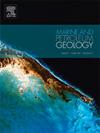核磁共振技术在页岩油储层表征及CO2增采中的应用综述
IF 3.7
2区 地球科学
Q1 GEOSCIENCES, MULTIDISCIPLINARY
引用次数: 0
摘要
由于低孔隙度、低渗透、多尺度孔隙空间和复杂的流体成分,页岩油储层的表征和开发面临着巨大的挑战。应用于页岩油层的核磁共振技术包括一维(1D)核磁共振T2图、二维(2D)核磁共振T1-T2图、核磁共振成像(MRI)技术和分层T2技术。1D T2图无损表征了页岩油储层全尺寸孔径分布(PSD),可与其他实验方法结合扩展功能:(1)结合离心和热处理,确定核磁共振T2截止值,定量区分可动流体、毛细束缚流体和不可动流体;(2)结合围岩心固定器,可以表征页岩基质和裂缝系统的应力敏感性;(3)结合自吸实验,定量评价了自吸特性和润湿性;(4)基于在线高温高压CO2提高页岩油采收率(CO2- esor)装置,可定量计算动态采油系数。此外,2D T1-T2图在识别页岩油层不同赋存状态下各种流体类型和流体原位含量方面具有独特优势。在CO2-ESOR过程中,MRI技术具有表征气液界面空间分布的巨大潜力。然而,目前的分辨率通常不足以成像页岩油储层样品,特别是那些低孔隙度和渗透率的储层样品。分层T2技术提供了页岩油储层的空间分辨T2分布和油饱和度剖面。然而,这些应用仍然面临着挑战,例如开发新型探针,减轻顺磁性矿物对核磁共振测量的影响,以及提高核磁共振技术的分辨率能力。核磁共振技术的不断进步将进一步增强其在页岩油藏勘探开发中的应用。本文章由计算机程序翻译,如有差异,请以英文原文为准。
Application of nuclear magnetic resonance technology in reservoir characterization and CO2 enhanced recovery for shale oil: A review
The reservoir characterization and development for shale oil faces significant challenges due to low porosity, low permeability, multi-scale pore space, and complex fluid composition. Nuclear magnetic resonance (NMR)technologies applied in shale oil reservoirs include one-dimensional (1D) NMR T2 map, two-dimensional (2D) NMR T1-T2 map, nuclear magnetic imaging (MRI) technology, and stratified T2 technology. The 1D T2 map nondestructively characterizes the full-scale pore size distribution (PSD) of shale oil reservoirs and can be combined with other experimental methods to extend the functions: (1) Through combining with centrifugation and thermal treatment, the NMR T2 cutoff value can be determined to quantitatively distinguish movable fluid, capillary bound fluid, and immovable fluid; (2) In conjunction with a confining core holder, stress sensitivity of the shale matrix and fracture systems can be characterized; (3) Through combining with spontaneous imbibition experiments, the spontaneous imbibition characteristics and wettability can be quantitatively evaluated; (4) Based on an online high-temperature and high-pressure CO2 enhanced shale oil recovery (CO2-ESOR) apparatus, dynamic oil recovery factors can be quantitatively calculated. Furthermore, the 2D T1-T2 map has unique advantages in the identification of various fluid types and in-situ content of fluids in different occurrence states in shale oil reservoirs. MRI technology has significant potential to characterize the spatial distribution of the gas-liquid interface during the CO2-ESOR process. However, current resolution capabilities are generally inadequate for imaging shale oil reservoir samples, particularly those with low porosity and permeability. The stratified T2 technology provides spatially resolved T2 distributions and profiles of oil saturation in shale oil reservoirs. However, these applications still face challenges, such as developing novel probes, mitigating the impact of paramagnetic minerals on NMR measurement, and enhancing the resolution capabilities of MRI technology. The continuous advancement of NMR technology will further enhance the applications in the exploration and development of shale oil reservoirs.
求助全文
通过发布文献求助,成功后即可免费获取论文全文。
去求助
来源期刊

Marine and Petroleum Geology
地学-地球科学综合
CiteScore
8.80
自引率
14.30%
发文量
475
审稿时长
63 days
期刊介绍:
Marine and Petroleum Geology is the pre-eminent international forum for the exchange of multidisciplinary concepts, interpretations and techniques for all concerned with marine and petroleum geology in industry, government and academia. Rapid bimonthly publication allows early communications of papers or short communications to the geoscience community.
Marine and Petroleum Geology is essential reading for geologists, geophysicists and explorationists in industry, government and academia working in the following areas: marine geology; basin analysis and evaluation; organic geochemistry; reserve/resource estimation; seismic stratigraphy; thermal models of basic evolution; sedimentary geology; continental margins; geophysical interpretation; structural geology/tectonics; formation evaluation techniques; well logging.
 求助内容:
求助内容: 应助结果提醒方式:
应助结果提醒方式:


